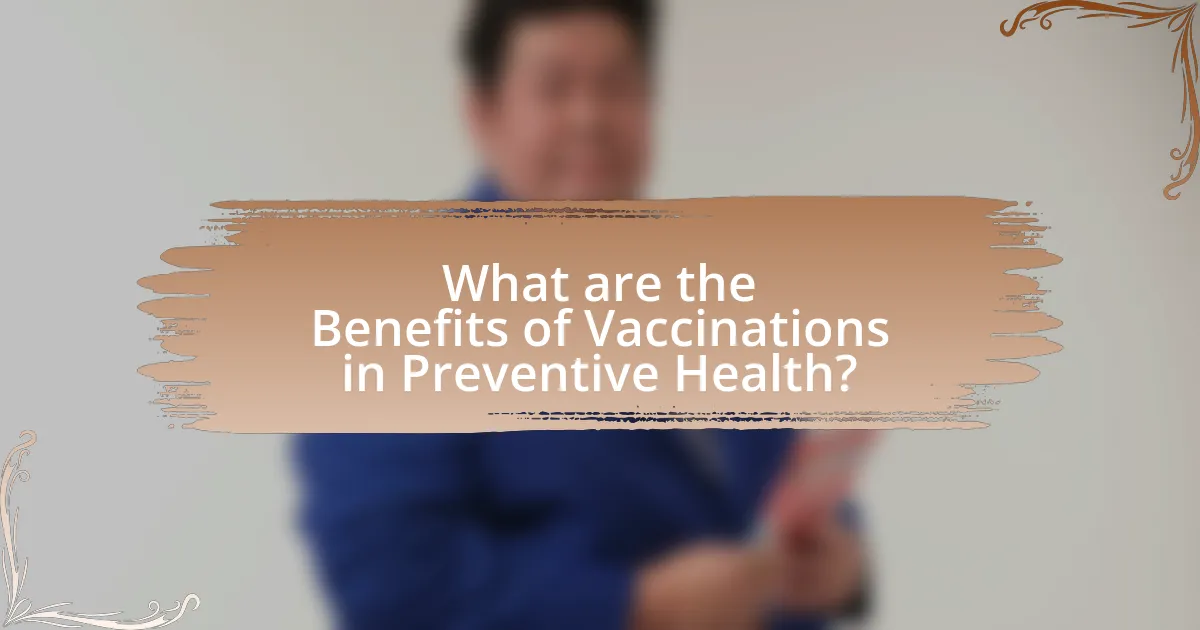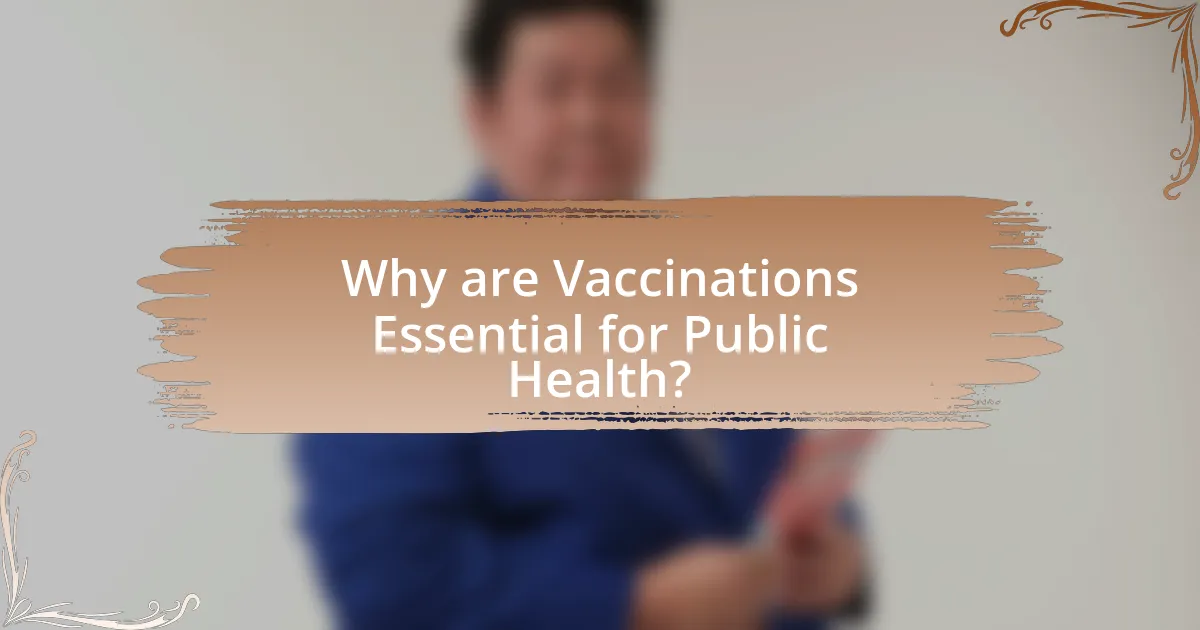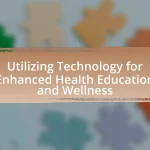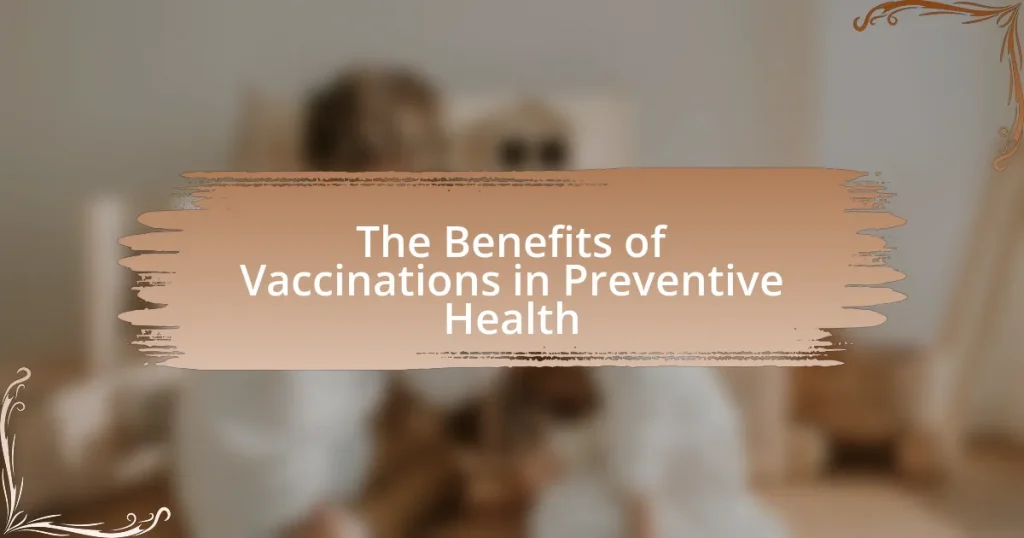Vaccinations are a vital component of preventive health, significantly reducing the incidence of infectious diseases and preventing millions of deaths annually. They enhance individual immunity by stimulating the immune system to recognize and combat specific pathogens, while also contributing to herd immunity that protects vulnerable populations. The article outlines the specific diseases preventable by vaccines, the societal and economic benefits of widespread vaccination, and the challenges faced in vaccination efforts, including misinformation and vaccine hesitancy. It emphasizes the critical role of healthcare providers and technology in promoting vaccination awareness and access, ultimately highlighting the long-term advantages of maintaining robust vaccination programs for public health.

What are the Benefits of Vaccinations in Preventive Health?
Vaccinations play a crucial role in preventive health by significantly reducing the incidence of infectious diseases. They work by stimulating the immune system to recognize and combat pathogens, thereby preventing outbreaks and protecting both individuals and communities. For instance, the World Health Organization reports that vaccines prevent 2-3 million deaths each year from diseases such as measles, polio, and tetanus. Additionally, widespread vaccination can lead to herd immunity, which protects those who cannot be vaccinated, such as infants and individuals with certain medical conditions. This collective immunity is vital for controlling diseases and minimizing healthcare costs associated with outbreaks.
How do vaccinations contribute to individual health?
Vaccinations contribute to individual health by stimulating the immune system to recognize and combat specific pathogens, thereby preventing diseases. When a person receives a vaccine, it introduces a harmless component of the pathogen, such as an inactivated virus or a piece of its genetic material, prompting the immune system to produce antibodies. This process not only protects the vaccinated individual from future infections but also reduces the severity of illness if exposure occurs. For instance, the Centers for Disease Control and Prevention (CDC) reports that vaccines have led to a significant decline in diseases like measles and polio, demonstrating their effectiveness in enhancing individual health and preventing outbreaks.
What specific diseases can vaccinations prevent?
Vaccinations can prevent specific diseases such as measles, mumps, rubella, polio, hepatitis A, hepatitis B, influenza, human papillomavirus (HPV), and varicella (chickenpox). For instance, the measles, mumps, and rubella (MMR) vaccine has been shown to reduce the incidence of these diseases by over 90% in vaccinated populations, according to the World Health Organization. Additionally, the polio vaccine has led to a 99% reduction in polio cases globally since its introduction, demonstrating the effectiveness of vaccinations in preventing these serious diseases.
How do vaccinations enhance immunity?
Vaccinations enhance immunity by introducing a harmless component of a pathogen, such as an inactivated virus or a piece of its genetic material, which stimulates the immune system to recognize and combat the actual pathogen in the future. This process leads to the production of specific antibodies and the activation of memory cells, which remain in the body and provide long-term protection. For instance, the measles vaccine has been shown to reduce the incidence of measles by over 90%, demonstrating the effectiveness of vaccinations in building immunity against infectious diseases.
What are the societal benefits of widespread vaccination?
Widespread vaccination provides significant societal benefits, including herd immunity, reduced healthcare costs, and enhanced public health. Herd immunity occurs when a large portion of the population becomes immune to a disease, thereby protecting those who cannot be vaccinated, such as individuals with certain medical conditions. This phenomenon has been evidenced by the near eradication of diseases like measles and polio in regions with high vaccination rates.
Additionally, widespread vaccination leads to decreased healthcare costs by reducing the incidence of disease outbreaks, which can strain healthcare systems. For example, the Centers for Disease Control and Prevention (CDC) estimates that vaccines prevent approximately 21 million hospitalizations and 732,000 deaths among children born in the last two decades in the United States alone.
Furthermore, vaccinations contribute to improved productivity and economic stability by preventing illness-related absenteeism in the workforce. The World Health Organization (WHO) highlights that every dollar spent on vaccination can yield a return of up to $44 in economic benefits. These factors collectively underscore the critical role of widespread vaccination in promoting societal health and economic well-being.
How do vaccinations contribute to herd immunity?
Vaccinations contribute to herd immunity by increasing the proportion of immune individuals in a population, which reduces the overall spread of infectious diseases. When a significant percentage of the population is vaccinated, it creates a barrier that protects those who are unvaccinated or cannot be vaccinated, such as individuals with certain medical conditions. For example, studies show that when vaccination rates exceed 90-95% for diseases like measles, the likelihood of outbreaks diminishes significantly, as the virus has fewer hosts to infect. This collective immunity is crucial for controlling and potentially eradicating diseases, as evidenced by the dramatic decline in cases of diseases like polio and smallpox following widespread vaccination campaigns.
What economic advantages do vaccinations provide to communities?
Vaccinations provide significant economic advantages to communities by reducing healthcare costs and increasing productivity. By preventing diseases, vaccinations lower the incidence of illness, which in turn decreases the burden on healthcare systems and reduces expenditures related to hospitalizations and treatments. For instance, the CDC estimates that childhood vaccinations alone save the U.S. healthcare system approximately $69 billion annually in direct costs. Additionally, healthier populations contribute to a more productive workforce, as fewer sick days lead to increased economic output. This dual impact of cost savings and enhanced productivity underscores the economic benefits of vaccinations for communities.

Why are Vaccinations Essential for Public Health?
Vaccinations are essential for public health because they prevent the spread of infectious diseases and protect communities through herd immunity. By immunizing a significant portion of the population, vaccinations reduce the likelihood of outbreaks, thereby safeguarding vulnerable individuals who cannot be vaccinated, such as infants or those with compromised immune systems. For instance, the World Health Organization reported that vaccines prevent 2-3 million deaths each year from diseases like measles and diphtheria. Furthermore, widespread vaccination programs have led to the eradication of smallpox and a dramatic decline in polio cases globally, demonstrating their effectiveness in controlling diseases.
How do vaccinations reduce the spread of infectious diseases?
Vaccinations reduce the spread of infectious diseases by enhancing the immune response in individuals, which leads to herd immunity. When a significant portion of a population is vaccinated, the overall transmission of the disease is decreased, as fewer individuals are susceptible to infection. For example, the Centers for Disease Control and Prevention (CDC) reported that the widespread use of the measles vaccine has led to a 99% reduction in measles cases in the United States since its introduction. This reduction in cases not only protects vaccinated individuals but also limits the opportunities for the virus to spread, thereby safeguarding those who cannot be vaccinated, such as infants and individuals with certain medical conditions.
What role do vaccinations play in controlling outbreaks?
Vaccinations play a critical role in controlling outbreaks by providing immunity to individuals and reducing the spread of infectious diseases within populations. When a significant portion of a community is vaccinated, herd immunity is established, which protects those who cannot be vaccinated, such as individuals with certain medical conditions. For example, the widespread vaccination against measles has led to a dramatic decline in measles cases; the World Health Organization reported that global measles deaths decreased by 73% from 2000 to 2018 due to vaccination efforts. This demonstrates that vaccinations are essential in preventing outbreaks and protecting public health.
How do vaccinations impact healthcare costs?
Vaccinations significantly reduce healthcare costs by preventing diseases that would otherwise require expensive treatments. For instance, the Centers for Disease Control and Prevention (CDC) estimates that childhood vaccinations alone save the U.S. healthcare system approximately $69 billion in direct costs and $1.5 trillion in societal costs over the lifetimes of children born in a single year. By preventing outbreaks and reducing hospitalizations, vaccinations lower the overall financial burden on healthcare systems and families.
What are the long-term benefits of maintaining vaccination programs?
Maintaining vaccination programs provides long-term benefits such as the reduction of disease prevalence, herd immunity, and cost savings in healthcare. Vaccination significantly lowers the incidence of infectious diseases, as evidenced by the near eradication of smallpox and a dramatic decline in polio cases globally. Herd immunity protects vulnerable populations, including those who cannot be vaccinated due to medical reasons, by reducing the overall spread of diseases. Additionally, studies indicate that every dollar spent on vaccination programs can save approximately $3 in direct healthcare costs and up to $10 in additional societal costs, highlighting the economic advantages of sustained vaccination efforts.
How do vaccination programs affect future generations?
Vaccination programs significantly reduce the prevalence of infectious diseases in future generations. By achieving herd immunity, these programs protect individuals who cannot be vaccinated, such as infants and those with certain medical conditions. For instance, the World Health Organization reports that vaccination has led to a 99% reduction in diseases like smallpox and a substantial decline in polio cases globally. This not only decreases morbidity and mortality rates but also lowers healthcare costs and enhances overall public health. Consequently, future generations benefit from a healthier environment, reduced disease burden, and increased life expectancy due to the long-term effects of widespread vaccination.
What is the relationship between vaccination rates and public health outcomes?
Vaccination rates are directly correlated with positive public health outcomes, as higher vaccination coverage leads to reduced incidence of vaccine-preventable diseases. For instance, the World Health Organization reported that widespread vaccination has led to a 99% reduction in diseases like smallpox and significant declines in measles and polio cases. Additionally, a study published in the journal “Vaccine” found that increased vaccination rates can lead to herd immunity, protecting vulnerable populations who cannot be vaccinated. This evidence underscores the critical role of vaccinations in enhancing overall public health and preventing outbreaks.

What Challenges are Associated with Vaccination Efforts?
Vaccination efforts face several challenges, including vaccine hesitancy, logistical issues, and misinformation. Vaccine hesitancy, which is the reluctance or refusal to vaccinate despite the availability of vaccines, can significantly hinder immunization rates; for instance, a 2021 survey by the World Health Organization found that 23% of respondents expressed doubts about vaccine safety. Logistical issues, such as supply chain disruptions and inadequate healthcare infrastructure, can impede the timely distribution of vaccines, as seen during the COVID-19 pandemic when many countries struggled to secure sufficient doses. Misinformation, particularly spread through social media, can lead to public confusion and distrust, further complicating vaccination campaigns; a study published in the journal “Vaccine” indicated that exposure to misinformation was linked to lower vaccination intentions. These challenges collectively undermine the effectiveness of vaccination programs aimed at improving public health.
What misconceptions exist about vaccinations?
Misconceptions about vaccinations include the belief that vaccines cause autism, that natural infection provides better immunity than vaccination, and that vaccines contain harmful levels of toxins. The claim linking vaccines to autism originated from a discredited study by Andrew Wakefield in 1998, which has been thoroughly debunked by extensive research, including a 2019 study published in Annals of Internal Medicine involving over 650,000 children, which found no association between vaccines and autism. Additionally, while natural infections can provide immunity, they often come with severe health risks, whereas vaccines are designed to provide safe immunity without the associated dangers of the diseases they prevent. Lastly, vaccines do contain preservatives and adjuvants, but these are present in amounts deemed safe by health authorities, such as the CDC and WHO, which monitor vaccine safety rigorously.
How do misinformation and fear affect vaccination rates?
Misinformation and fear significantly decrease vaccination rates by creating distrust in vaccines and health authorities. Studies show that misinformation, such as false claims about vaccine safety, can lead to increased vaccine hesitancy; for instance, a 2020 survey indicated that 29% of respondents believed false information about vaccine side effects. Fear, often fueled by this misinformation, exacerbates hesitancy, as individuals may fear adverse effects or believe that vaccines are unnecessary. The World Health Organization identified vaccine hesitancy as one of the top ten global health threats, highlighting its impact on public health and the effectiveness of vaccination programs.
What strategies can be employed to combat vaccine hesitancy?
To combat vaccine hesitancy, effective strategies include enhancing public education, engaging trusted community leaders, and addressing misinformation. Public education initiatives can clarify vaccine benefits and safety, as evidenced by studies showing that informed individuals are more likely to vaccinate. Engaging trusted community leaders, such as healthcare professionals and local influencers, can foster trust and encourage vaccination uptake, as demonstrated in various community-based interventions. Additionally, addressing misinformation through targeted communication campaigns can reduce fears and misconceptions, supported by research indicating that correcting false information significantly improves vaccine acceptance rates.
How can healthcare systems improve vaccination outreach?
Healthcare systems can improve vaccination outreach by implementing targeted communication strategies that address community-specific concerns and barriers. For instance, utilizing data analytics to identify populations with low vaccination rates allows healthcare providers to tailor messages and outreach efforts effectively. Research indicates that community engagement initiatives, such as partnerships with local organizations and influencers, significantly enhance trust and participation in vaccination programs. A study published in the American Journal of Public Health found that targeted outreach increased vaccination rates by up to 30% in underserved communities. By focusing on culturally relevant messaging and accessible vaccination sites, healthcare systems can further increase vaccination uptake and improve public health outcomes.
What role do healthcare providers play in promoting vaccinations?
Healthcare providers play a crucial role in promoting vaccinations by educating patients about the benefits and safety of vaccines, addressing concerns, and facilitating access to immunization services. They serve as trusted sources of information, which is vital since studies show that patients are more likely to accept vaccinations when recommended by their healthcare providers. For instance, the CDC reports that healthcare provider recommendations significantly increase vaccination rates, with a 2018 study indicating that 79% of parents cited their child’s doctor as the most influential factor in their decision to vaccinate. By actively engaging in discussions about vaccines and providing clear, evidence-based information, healthcare providers help to reduce vaccine hesitancy and improve public health outcomes.
How can technology enhance vaccination awareness and access?
Technology can enhance vaccination awareness and access by utilizing digital platforms for education, appointment scheduling, and reminders. Mobile applications and websites can provide accurate information about vaccines, their benefits, and potential side effects, thereby increasing public knowledge. For instance, a study published in the Journal of Medical Internet Research found that mobile health interventions significantly improved vaccination rates by providing timely reminders and educational content. Additionally, telehealth services can facilitate consultations with healthcare providers, making it easier for individuals to address concerns and schedule vaccinations. This integration of technology not only streamlines the vaccination process but also fosters a more informed public, ultimately leading to higher vaccination uptake.
What practical steps can individuals take to support vaccination efforts?
Individuals can support vaccination efforts by educating themselves and others about the importance of vaccines. This includes sharing accurate information from reputable sources, such as the World Health Organization and the Centers for Disease Control and Prevention, which highlight that vaccines prevent diseases and save lives. Additionally, individuals can participate in vaccination campaigns by volunteering at local clinics or community events, helping to increase accessibility and awareness. Encouraging friends and family to get vaccinated and addressing their concerns with factual information can also enhance community vaccination rates. According to a study published in the journal “Vaccine,” community engagement significantly improves vaccination uptake, demonstrating the impact of individual actions on public health.










